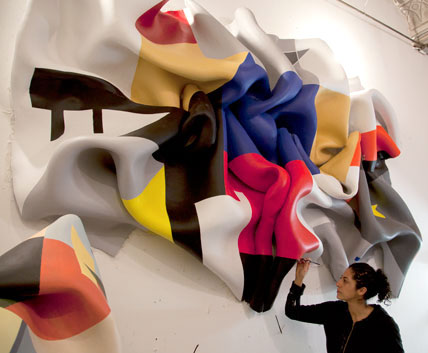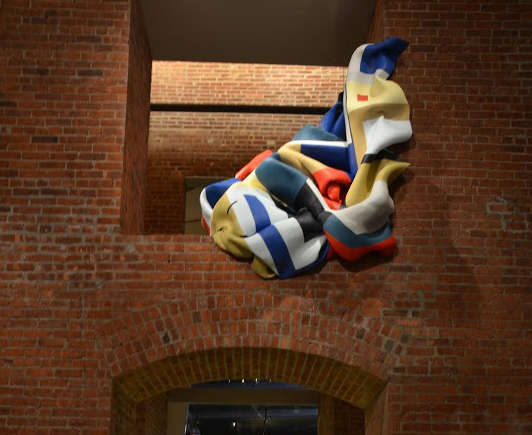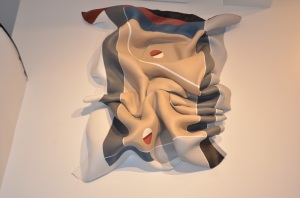
Marela Zacarias installs at Brooklyn Museum, 2013
nycARTscene’s Hannah Krafcik leads us in conversation with artist Marela Zacarias:
HK: Could you briefly give us a glimpse into the inspiration for your work, “Supple Beat,” which was part of the Brooklyn Museum’s 2013 “Raw/Cooked” series? What framework did the Brooklyn Museum provide for you to contextualize “Supple Beat” in the space? What did you want your work to bring to this space?
MZ: I wanted my works to look like murals that have escaped confinement and are now flaunting their colors and curves in the public section of the museum. I hoped to bring energy, color, and a bit of mischief into the space.
The museum told me I could propose to use any part of the building for my show, however unconventional that space might be. They also suggested that I worked with anything I wanted in their collection. They really opened their doors to me and were very supportive of all my choices. It was an amazing experience to work with such a professional group of people.
HK: You’ve said that you are a collector of patterns and shapes. Your geometric patterns appear rippling and activated across your sculptures. Would you elaborate on how you integrate these aesthetics, and where the impetus came from to do so?
MZ: Patterns and shapes are something I constantly look for and notice in my surroundings. I enjoy figuring out the shapes and the different color relationships that other people use in either a craft or a painting. My favorite patterns, shapes and colors, however, are usually found in nature.
When I design the patterns and the shapes on my sculptures I am reacting instinctively to the curves of my pieces. I can see the shapes and lines on the surface before I paint them. The more curves there are the more exciting it is for me to “draw” lines across them. I really enjoy drawing on a 3-dimensional surface because I have to think about the composition from every angle, which creates a very dynamic relationship with the works.
Even though my shapes look very geometric and maybe rational, they are not. If my sculptural paintings were to be somehow unfolded, the shapes would not make any sense at all.

Marela Zacarias installation at Brooklyn Musuem
HK: The apparent suppleness and activity of this work seems to underscore the concept of resilience that inspires much of your work. Would you discuss how you’ve developed this theme of resilience through your practice?
MZ: It is part of my nature to side with the underdogs- in life and in sports. There is something very inspiring to me about becoming stronger and prevailing against the odds.
The concept of resilience is also in the material of the sculptures and in the process of making them- I transform something fragile (the window screen) into a strong sculpture through a long process of layering and sanding. I like to think of this process as a metaphor for the themes I am trying to explore. Making something stronger than it was is also very empowering and satisfying, that’s why I try to do it every day.
HK: You haven’t been in the city for an extended period of time. Tell us a bit about your journey from Mexico City to New York, along with the development of your aesthetic practice through that period.
MZ: I left Mexico when I was 17 years old to go to Kenyon College in Ohio. I absolutely loved my time there. In fact, many of my greatest friends are from when I was there; after I graduated I moved to Washington DC and I started painting murals. I was also painting oils on canvas at that time. After a few years and a long stay in Mexico City I moved to Connecticut, where I taught art and painted murals all over the place. I also became very involved in activism.
By then I had been painting for 10 years and I was yearning for a change in my practice, so I started creating three-dimensional murals in the gallery space. I felt like doing this opened a floodgate that was hard to stop. All of a sudden everything I had was not enough. So I applied to the Hunter MFA program and I moved to New York.
Graduate school was an amazing experience for me. Being able to create art full time and be part of a community of artists gave me all the room I needed to explore and define my own artistic language. This exploration never ends, of course, but at least now I feel like I am moving in the right direction.

HK: Finally (and I’m very curious about this)—the sculpture in “Supple Beat” covers a television in the Great Hall. What inspired this, and what television program is the sculpture covering?
MZ: The Williamsburg Murals were painted for walls in the common areas (basements) of the public housing units. They were meant to aid relaxation for workers after a long day of work. There is something so utopian about this concept that I thought it would be worth exploring it through the eyes of the present. I kept thinking about how hard it would be for a painting to have to compete for attention with a TV monitor and all the entertainment that it represents.
For this installation of the work I recorded some TV shows at my friend’s house (as I don’t own a television) We had a good time changing channels, so there is a little bit of everything in the mix: The Daily Show (with Jon Stewart and Christopher Walken), Toddlers and Tiaras, Jeopardy, lots of commercials, etc. The idea is that in future installations of the piece, the monitor can be plugged to anything you chose- cable, DVD player, etc., and the viewer will have the choice to change channels, enjoy a show or a movie, or turn the TV off. The sculpture was made directly on the monitor so they are completely inseparable.
Marela Zacarias: http://marela.org/
photos: Pierce Jackson, Marela Zacarias

No comments yet.